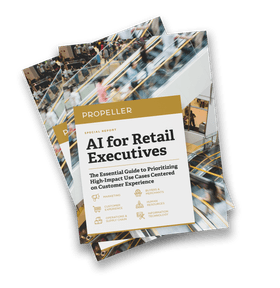The rise of agentic AI has enterprises racing to deploy AI agents across workflows and business functions, often with mixed results. As organizations rush to experiment with this new technology, many are approaching this with the wrong mindset. Rather than asking “What are all the workflows I can now automate using agentic AI?”, leaders should instead be asking “Where can agentic AI deliver value today without excessive risk and complexity?"
In our work with enterprise leaders, we’ve seen that starting small and scaling smart leads to the most sustainable success. The key is to use a maturity-based framework to identify agentic AI use cases that are feasible, valuable, and responsible, aligning with today’s capabilities, while laying a foundation that is ready for the future.
Going "full autonomy" too soon is a fast track to failed pilots, compliance nightmares, and organizational fatigue, which reduces an organization's ability to capture the benefits of agentic AI now and as technologies mature.
For leaders new to this space, our primer on what agentic AI is and why it’s the next frontier in enterprise automation provides essential background on the concepts discussed throughout this guide.
Related Content: What is Agentic AI and Why It's the Next Frontier in Enterprise Automation
# The Agentic AI Use Case Prioritization Framework
Not every process is ready for agentic AI, and not every AI pilot is worth the investment. That’s why it’s crucial to evaluate potential use cases from a practical perspective.
At Propeller, we use a 2x2 prioritization framework to help clients identify use cases that are both impactful and achievable. The framework evaluates opportunities across two dimensions:
# 1. Complexity
Complexity encompasses the predictability of inputs, context requirements, data quality, risk and compliance considerations, and the degree of human judgment required to complete a use case successfully. Low-complexity use cases feature predictable logic and inputs, such as document summarization or internal routing. High-complexity use cases require high contextual awareness and nuanced judgment, such as interpreting policies in regulated environments. Risk scales directly with complexity, making higher-complexity use cases require greater caution and oversight.
# 2. Volume
Volume measures both frequency and impact: how often does this process occur, and how much time or effort does each instance require? Consider questions like “How many password reset tickets do we process weekly?” or “How often do we need to refresh shift schedules?” to gauge whether automation will drive measurable value.
For organizations with limited AI maturity, low-volume use cases rarely justify the investment needed to achieve meaningful ROI.
# The Sweet Spot
By mapping complexity against process volume, organizations can identify opportunities that deliver the greatest return with the least risk:
- High volume enough to drive measurable ROI
- Low complexity enough to automate with current agentic capabilities
- Safe to pilot without introducing excessive risks
These agent-ready tasks can be deployed quickly, governed with confidence, and scaled effectively, forming the foundation for broader adoption of agentic AI.
# Agentic AI Prioritization Matrix
Low Complexity | High Complexity | |
High Volume | Pilot Zone – Ideal for agentic AI: repetitive, high-volume (often tedious) tasks with generally predictable logic and inputs. | Plan for Future Growth – May require more sophisticated agent orchestration or mature governance to safely implement and avoid undue risk. |
Low Volume | Low Scalability – Not worth automating at the organizational level, but potential for localized experimentation within teams or departments. | Avoid for Now – High risk and low return, better left to human expertise until agentic maturity improves. |
This framework helps teams prioritize use cases where agentic AI is most likely to succeed today, while identifying those requiring greater maturity to implement safely.
Organizations should focus initial use cases within the 'pilot zone' to capture tangible ROI and build the foundation for scalable, responsible automation as agentic capabilities mature.
For “plan for future growth” opportunities, establish clear capability milestones rather than waiting indefinitely. Even “low scalability” use cases can provide valuable departmental insights that inform broader strategies.
When evaluating where to invest, leaders should consider both current processes and net-new capabilities that agentic AI uniquely enables, applying the same volume and complexity lens.
Related Content: Building Your Enterprise AI Chatbot Compass
# Agentic AI Use Cases to Start With Today
Agentic AI is already delivering tangible value in well-defined, lower-risk areas, particularly high-volume, rules-based tasks that drain team capacity. For most organizations, the best starting points are operational workflows that don’t require deep human judgment but still slow things down.
Here are a few use cases across industries that balance innovation and controlled risk:
Retail & Consumer Products
- Store operations support: Automating inventory exception handling or generating shift schedules based on demand forecasts.
- Content routing: Classifying marketing assets and tagging them for the right region, channel, or compliance level.
- Onboarding frontline employees: Coordinating documentation, training assignments, and access provisioning.
Tech & Software Companies
- Internal help desk: Handling Tier 0 IT requests, like password resets and software access.
- Customer support: Addressing initial customer inquiries, providing 24/7/365 support, and deflecting routine requests from human support agents.
- Predictive hardware maintenance: Autonomously monitoring equipment performance data to predict potential hardware failures and proactively initiating maintenance requests before issues disrupt operations.
Energy & Utilities
- Regulatory document routing: Sorting inspection reports and permit filings to appropriate reviewers or systems.
- Maintenance ticket triage: Prioritizing field service requests based on severity, location, or SLAs.
- Safety training logistics: Automating certification tracking and scheduling renewals for frontline workers.
Public Sector
- Application processing: Reviewing intake forms and routing them to the appropriate departments or caseworkers.
- Grants and funding workflows: Validating documentation, issuing reminders, and managing review cycles.
- Employee onboarding coordination: Supporting cross-agency task management in complex unionized environments.
These tasks share common characteristics: they’re manual, time-intensive, and don’t require the nuance, empathy, or judgment that justifies human handling. With the right guardrails and governance, agentic AI can support the humans currently tackling these tasks, freeing up hours of time and delivering direct cost savings.
# Where Not to Go (Yet): Red Flags for Agentic AI Deployment
Despite what many vendors and startups claim, agentic AI isn’t ready for everything. Neither are most organizations, especially when it comes to the scaffolding required to support agentic AI, such as governance structures and AI-digestible data stores.
Related Content: AI Governance: How an AI Council Could Make or Break Your Strategy
Here are some signs that a process may be better suited to humans, at least for now:
- High context dependency: Tasks where inputs vary wildly or require deep institutional knowledge, such as interpreting policy in regulated environments or helping employees understand organizational cultural norms.
- Strict compliance environments: Financial approvals, legal disclosures, and healthcare communications carry too much risk for autonomous handling.
- Emotional intelligence matters: Escalated customer service interactions, sensitive HR matters, or situations requiring empathy and nuance.
Missteps in these areas carry significant reputational, legal, or cultural risks that today’s agentic AI solutions aren’t equipped to manage. Revisit these use cases as agentic capabilities and governance structures mature.
# Scaling Agentic AI With Intent, Not Just Excitement
Starting small doesn’t mean thinking small or holding back innovation. When done right, early deployments of agentic AI become strategic launchpads. They help organizations:
- Build internal confidence and buy-in with key stakeholders
- Develop AI-ready infrastructure and governance
- Create feedback loops and building blocks for smarter, more contextual agents
Organizations that treat these first steps as capability-building, not just cost-saving, set themselves up for sustainable, scalable success as technical and organizational maturity evolves.
The investments and experiments you make today will deliver more than short-term wins. They’ll shape the ecosystem that supports future AI solutions, making implementation smoother for solution engineers, architects, and business teams alike.
Related Content: Measuring AI ROI: How to Build an AI Strategy That Captures Business Value
# Don’t Let Old Workflows Hinder Innovation
It is important to note that while much of the early focus on agentic AI is on streamlining and automating existing workflows, forward-thinking organizations are also creating entirely new processes that wouldn’t have been feasible (or even imaginable) before these technologies. Agentic AI opens the door to innovative business models and customer experiences that transcend simple automation.
For example, organizations can deploy agents to proactively identify and address customer pain points by continuously monitoring support channels and automatically surfacing emerging trends for product teams. In operations, AI agents can coordinate just-in-time training programs based on real-time competency gaps or orchestrate dynamic cross-functional project teams as new business opportunities arise.
By designing workflows that harness agentic AI’s ability to reason, plan, and act autonomously, businesses can unlock new sources of value, whether it’s hyper-personalized customer engagement, adaptive supply chain management, or continuous compliance monitoring. The key is to treat agentic AI not just as a tool for optimization, but as a catalyst for reimagining how work gets done.
# Putting Agentic AI to Work
At Propeller, we help enterprises navigate agentic AI with maturity-based, value-focused, and risk-aware approaches, so that early efforts not only succeed but also scale.
Whether you’re identifying your first use case or scaling existing programs, we work with you to build a roadmap that fits your business, technology stack, and risk profile.
Thinking through how to prioritize agentic AI? You might also enjoy Agentic AI: The Next Evolution of Personalization Marketing, which traces how personalization itself is shifting to work with more autonomous, context-sensitive intelligence.
Ready to identify your strongest agent-ready opportunities? Let's talk agentic AI strategy.

AI for Retail Leaders: Use Case Guide
Learn how leading retailers are using AI to enhance CX, streamline operations, and deliver value.




